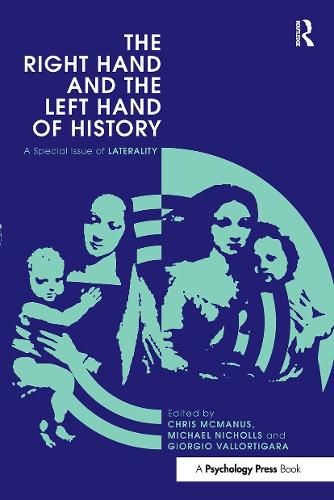Readings Newsletter
Become a Readings Member to make your shopping experience even easier.
Sign in or sign up for free!
You’re not far away from qualifying for FREE standard shipping within Australia
You’ve qualified for FREE standard shipping within Australia
The cart is loading…






Left-handers have been described as "a people without a history". This special issue provides scholarly analyses of aspects of asymmetry in history, from the Renaissance to the 20th Century.
Lauren Harris presents three studies describing:
An 1811 American child-care manual for parents fearing, "lest their children should be left-handed"; Manuals on swordsmanship from the Renaissance onwards describing the "accepted minority" of left-handed swordsmen, a minority that still dominates the Olympics; The enigmatic bias whereby parents use their left arm to carry babies;
Janet Snowman and Stephen Christman present two papers on left-handed musical geniuses:
William Crotch, the self-taught, 18th Century, musical prodigy, whose unconventional left-handed playing styles stimulate many questions about the asymmetries of stringed instruments; Jimi Hendrix, the 20th Century, left-handed, guitarist of whom Robert Krieger said, "... he was just so different. He just came from such a left-field place."
Chris McManus, Richard Rawles, James Moore and Matthew Freegard describe an early BBC TV programme presented in 1953 by Jacob Bronowski on right and left-handedness. In an early example of viewer participation, 6000 people sent postcards describing their handedness and also their perceptions of a "mystery picture", that was the duck-rabbit figure from Wittgenstein's recently published Philosophical Investigations. Chris McManus and Janet Snowman describe A left-handed compliment, a newly discovered lithograph by John Lewis Marks (ca. 1795-6 - ca. 1857-61). Given Marks',"seeming love of vulgarity for its own sake", there is probably an obscene sub-text reminiscent of a Donald McGill postcard.
$9.00 standard shipping within Australia
FREE standard shipping within Australia for orders over $100.00
Express & International shipping calculated at checkout
Left-handers have been described as "a people without a history". This special issue provides scholarly analyses of aspects of asymmetry in history, from the Renaissance to the 20th Century.
Lauren Harris presents three studies describing:
An 1811 American child-care manual for parents fearing, "lest their children should be left-handed"; Manuals on swordsmanship from the Renaissance onwards describing the "accepted minority" of left-handed swordsmen, a minority that still dominates the Olympics; The enigmatic bias whereby parents use their left arm to carry babies;
Janet Snowman and Stephen Christman present two papers on left-handed musical geniuses:
William Crotch, the self-taught, 18th Century, musical prodigy, whose unconventional left-handed playing styles stimulate many questions about the asymmetries of stringed instruments; Jimi Hendrix, the 20th Century, left-handed, guitarist of whom Robert Krieger said, "... he was just so different. He just came from such a left-field place."
Chris McManus, Richard Rawles, James Moore and Matthew Freegard describe an early BBC TV programme presented in 1953 by Jacob Bronowski on right and left-handedness. In an early example of viewer participation, 6000 people sent postcards describing their handedness and also their perceptions of a "mystery picture", that was the duck-rabbit figure from Wittgenstein's recently published Philosophical Investigations. Chris McManus and Janet Snowman describe A left-handed compliment, a newly discovered lithograph by John Lewis Marks (ca. 1795-6 - ca. 1857-61). Given Marks',"seeming love of vulgarity for its own sake", there is probably an obscene sub-text reminiscent of a Donald McGill postcard.